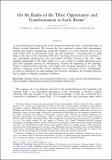Files in this item
On the banks of the Tiber : opportunity and transformation in early Rome
Item metadata
| dc.contributor.author | Brock, Andrea L. | |
| dc.contributor.author | Motta, Laura | |
| dc.contributor.author | Terrenato, Nicola | |
| dc.date.accessioned | 2021-06-24T16:30:02Z | |
| dc.date.available | 2021-06-24T16:30:02Z | |
| dc.date.issued | 2021-05-21 | |
| dc.identifier | 274589007 | |
| dc.identifier | 1a808bc6-7bac-4867-9264-f3aa8427e6de | |
| dc.identifier | 85106902060 | |
| dc.identifier | 000728252100001 | |
| dc.identifier.citation | Brock , A L , Motta , L & Terrenato , N 2021 , ' On the banks of the Tiber : opportunity and transformation in early Rome ' , Journal of Roman Studies , vol. First View . https://doi.org/10.1017/S0075435821000344 | en |
| dc.identifier.issn | 0075-4358 | |
| dc.identifier.other | RIS: urn:03507E0FEE93557AA9E8E32C0D12E035 | |
| dc.identifier.other | ORCID: /0000-0001-5390-7499/work/95418655 | |
| dc.identifier.uri | https://hdl.handle.net/10023/23417 | |
| dc.description | Funds for the research were generously provided by the Loeb Classical Library Foundation, Gerda Henkel Foundation, American Philosophical Society, Etruscan Foundation, Fondazione Lemmermann, University of Michigan and University of St Andrews. The lead author wrote this article while supported by an Early Career Fellowship from the Leverhulme Trust. | en |
| dc.description.abstract | A geoarchaeological coring survey of the Forum Boarium has shed considerable light on Rome's archaic landscape. We present the first empirical evidence that substantiates ancient and modern assumptions about the existence of a river harbour and ford in early Rome. Prior to the growth of the city, the riverbank-reconstructed as a high ledge at the base of the Capitoline Hill and a low-lying shore north of the Aventine-was particularly advantageous for river-related activities. However, the river valley changed significantly in the sixth century b.c.e., as a result of complex fluvial processes that were arguably spurred by urbanisation. Around the beginning of the Republic, Rome's original harbour silted up, and a high, wide riverbank emerged in its place. The siltation continued until the Forum Boarium was urbanised in the mid-Republic. In order to build their city and maintain river harbour operations, the Romans therefore had to adapt to dynamic ecological conditions. | |
| dc.format.extent | 30 | |
| dc.format.extent | 1552472 | |
| dc.language.iso | eng | |
| dc.relation.ispartof | Journal of Roman Studies | en |
| dc.subject | Archaic Rome | en |
| dc.subject | Coring survey | en |
| dc.subject | Environmental archaeology | en |
| dc.subject | Fluvial landscapes | en |
| dc.subject | Historiography | en |
| dc.subject | Human-environment interactions | en |
| dc.subject | Urbanisation | en |
| dc.subject | PA Classical philology | en |
| dc.subject | CC Archaeology | en |
| dc.subject | T-NDAS | en |
| dc.subject | SDG 11 - Sustainable Cities and Communities | en |
| dc.subject.lcc | PA | en |
| dc.subject.lcc | CC | en |
| dc.title | On the banks of the Tiber : opportunity and transformation in early Rome | en |
| dc.type | Journal article | en |
| dc.contributor.sponsor | The Leverhulme Trust | en |
| dc.contributor.institution | University of St Andrews. School of Classics | en |
| dc.identifier.doi | 10.1017/S0075435821000344 | |
| dc.description.status | Peer reviewed | en |
| dc.identifier.grantnumber | ECF-2019-518 | en |
This item appears in the following Collection(s)
Items in the St Andrews Research Repository are protected by copyright, with all rights reserved, unless otherwise indicated.

